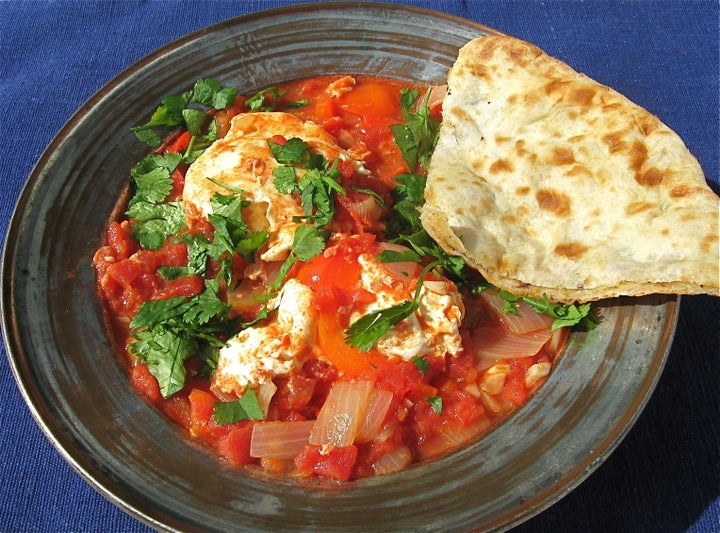
An age-old symbol of life and renewal, the egg has taken on considerable baggage in recent years. Forget the happy farm, the downy chicks, the clucking hens -- here's the hard-boiled reality -- we've got hens working their heinies off to feed America's astounding egg demand -- 76 billion eggs a year.
For commercial egg producers, getting that many eggs to gobbling consumers means cramming more chickens into less space, a practice known as battery cages or factory farming. The chickens never see daylight, never even see their feet. They're packed in so tightly, they can't spread their wings. The Humane Society estimates 280 million hens across the country are raised in battery cages. They, PETA and Jonathan Saffran Foer's Eating Animals have shown what goes on in most so-called hen houses will take away your appetite.
If you want to take a step back to the pure, bucolic life an egg evokes, the World Society for Protection of Animals (WSPA) asks you to make a modest new year's resolution -- switch from commercially raised eggs to buying those labeled "Certified Humane," "American Humane Certified," or "Animal Welfare Approved." This means your eggs came from chickens raised with care, not confined to battery cages and stuffed with weird growth hormones or antibiotics. And these three designations are verified and monitored by animal rights organizations. In other words, they have some oomph behind them, unlike popular claims like "cage-free," which does not.
"Egg producers commonly misrepresent with misleading labeling," explains Erica Meier, executive director of Compassion Over Killing (COK). How do these companies get away with it? While the USDA created standards, they do not enforce or oversee egg production. "There is no federal oversight on egg cartons. Much of what consumers are seeing are voluntary claims."
Meanwhile, in Europe, egg producers "are required to label how their eggs are produced," says Meier. We're lagging behind Europe. Frankly, it's just getting embarrassing.
For the good of the consumer, the good of the country, the good of the chicken and egg, WSPA created Eat Humane, a site demystifying humane food labeling. "You can plug in the name of your grocery store and pick the kind of food you want to buy. All the brands will be listed by whether they're good, better or best" in terms of humane production," says says WSPA's new US manager Sharanya Krishna Prasad. "It gives people the tools to make the right decisions. Americans are concerned about how farm animals are raised and what the labels mean."
Meier agrees. "A growing number of consumers are learning more about the reality of where their food comes from."
It's caused the commercial egg industry to see the egg yolk on the wall. They're pushing back, claiming humanely-produced eggs could result in more food safety issues. Ahem -- more? The FDA estimates salmonella-tainted eggs sickened 142,000 Americans last year. A European Food Safety Authority study indicates the risk of salmonella outbreak is up to 25% greater in commercially-produced eggs than those raised more humanely.
The egg industry claims humanely produced eggs will cost up to 25% more. True, most certified humane eggs are more expensive than those that are factory farmed. So? In his new book The Value of Nothing, Raj Patel refers to cheap food as cheat food, full of hidden costs -- the cost to the environment, the cost of unfair labor practices, the cost of animal abuse, the cost to our health. There's no such thing as a free lunch, ace. It costs us one way or another, and a Zogby study indicates we're willing to shell out more for cruelty-free food. We'd rather pay up front and with cash than put ourselves and natural resources at risk.
Amid the blizzard of information and misinformation, Americans want to do the right thing. "It's created major shifts," says Meier. "Some states have banned some of the cruelest factory farming practices." California's Proposition 2 has made battery cages illegal. The government's starting to get with the cruelty-free program, but don't count your chickens before they're humanely hatched. The real action begins with us, from speaking out against animal cruelty to choosing to scramble a humanely produced egg.
Chakchouka -- Eggs Poached in Spicy Tomato Sauce
This is a warming dish for winter, good for any meal of the day. It's known as chakchouka in Morocco and the Middle East, uovo diabolo in Italy, oeufs en cocotte in France, piperade in Basque, egg curry in India. Different names, different spicing, but under the shell, we're all the same. In every language, it translates into a quickie one-skillet meal made from only a handful of ingredients that transcend their simplicity. It's one of the great gourmet cheats, being much easier than it looks, and tastes so yummy it'll make you teary. Or maybe that's the jalapeno.
1 tablespoon olive oil
1 onion, chopped
4 cloves garlic, chopped fine
1 sweet red pepper, cut into skinny strips
1 jalapeno, chopped
1 15-ounce can chopped tomatoes (or about 2 cups ripe, fresh tomatoes, chopped --
good luck getting those in January if you're anywhere but South Florida)
1 good pinch red pepper flakes
4 certified humane eggs *
sea salt and freshly ground pepper to taste
a handful fresh cilantro or parsley, chopped
*Go egg-free and vegan by substituting 8 ounces of sliced extra-firm tofu in place of eggs.
Heat oil in a large skillet over medium-high heat. Add chopped onions, garlic, jalapeno and red pepper. Stir until vegetables soften, about 8 minutes.
Add chopped tomatoes, Stir together well. Reduce heat to low and cover skillet, letting flavors blend, for about 10 minutes.
Remove lid, season to taste with salt and pepper.
Bring heat back up to high and bring tomato-pepper mixture to boil. When it's bubbling, crack eggs into the skillet.
Reduce heat to medium-high and cover again, for another 5 to 8 minutes. Add chopped cilantro or parsley. Serve with pita or crusty bread to soak up the great sauce.
Serves 2.
Recipe doubles easily.
